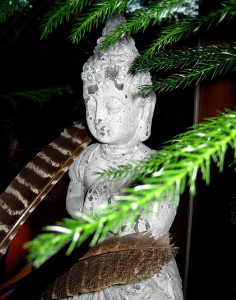
– Photo by Jan Ketchel
The riddle of the sphinx questions: What has four legs in the morning, two in the afternoon and three in the evening. The answer, for those who haven’t solved it, is humankind. The full life cycle is crawling on all fours in childhood, walking on two legs in the afternoon of life, and ending the day—and a cycle of life—with a cane, the third leg of old age.
Buddha realized that the only way to transcend suffering was to accept and acquiesce to the full truth of this cycle. In my blog last week, the I Ching advised that to restore ourselves to the Tao, we must acquiesce to the requirements of each stage of the day, of the cycle of life, without trying to stretch and extend one part of the cycle into and at the expense of the next.
This week, I asked the I Ching how to achieve this balance when the needs of one part of the tripartite self of day, afternoon and evening infiltrates or takes control of the whole of life. From the hexagram of Following, #17, I get the following advice: “He follows the man of age and experience and lets the little boy go. He will find what he seeks.” -From the I Ching, p. 83, edition by Sam Reifler.
The guidance is blunt: Follow the lead of the sage, the old wise self; release the personality from the control of the demands of the child. The demands of the child are most appropriate to rule the first stage of life, childhood, but beyond that they only serve to confound the developmental process of maturity, so needed to meet the needs of the unfolding life cycle. Too often the needs of the child were ignored in childhood, which creates deficits, but these needs can only be addressed successfully by the more mature self that becomes the parent to the child self in adulthood. If the child’s demands continue to rule the personality beyond childhood, the developmental milestones needed to be reached to address the comprehensive needs of the self cannot be achieved and we stay fixated in childhood throughout the life cycle.
Even in the most horrific of circumstances, where childhood has been interrupted or denied, do we have access to the third leg of the tripartite self in the dreams of the night. In dreaming, the wise sage self leads us into worlds of developmental opportunity where the deepest needs of the chid and adult selves are experienced and addressed. To be available to this natural process, we must acquiesce to the night, releasing the light of day and opening to the rejuvenation of sleep.
Upon awakening, the energy, the mood, the realignment of the night offers itself to wakening awareness. As we move through the day, this sage self continues to guide us, alerting us to the synchronicities that resonate in daily life, that point the way to right action as we flow through the challenges of the day. We will indeed be confronted by the needs, fears, and desires of the child self, but the adult self, the noonday self, however compromised, always has access to its deeper sage self throughout the day. It is never alone, never without its needed guidance.
The challenge, the I Ching suggests, is to indeed follow the man of age and experience, the sage voice that guides, in an inner voice, in nightly dreams, and in the multitude of synchronicities that resonate each day.
Following,
Chuck
